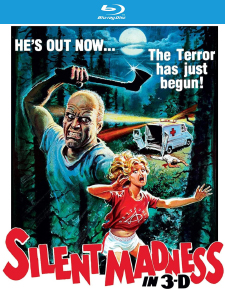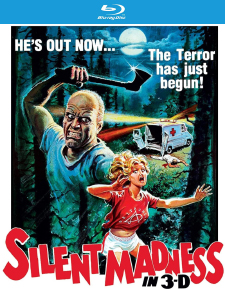Silent Madness (Blu-ray 3D Review)

Director
Simon NuchternRelease Date(s)
1984 (January 26, 2021)Studio(s)
Almi Pictures (Vinegar Syndrome)- Film/Program Grade: B-
- Video Grade: See Below
- Audio Grade: B
- Extras Grade: B+
Review
Silent Madness is a deeply strange but very interesting slasher movie that unfortunately was buried at the theatres in 1984 by A Nightmare on Elm Street. It was shot in 3D, but most audiences only saw the 2D version, and without that gimmick it never had a chance to gain a foothold at the box office against Wes Craven’s runaway hit. It hasn’t added much of a cult following in the decades since then, but thanks to the magic of Blu-ray 3D, audiences finally have a chance to see the film the way that it was originally intended to be seen. Of course, considering that most display manufacturers no longer offer 3D capability, Silent Madness may once again be the victim of bad timing.
Silent Madness is as disturbed as the inmates of the mental asylum prominently featured in its story. Or to be more precise, stories, as there are multiple narratives and genres compressed into its scant 93-minute running time. It feels like a slasher movie that’s been shoehorned into an institutional melodrama—it could have just as easily been titled Jason Goes to Bedlam. That’s actually not too far from the truth, because Silent Madness was originally conceived as a thriller set in a mental institution, and the other elements were added later during development. There’s even a touch of Coma-inspired science fiction at one point. It’s ironic that none of the patients in the asylum suffer from dissociative personality disorder, because the film itself does. Yet while the disparate elements don’t really gel for most of the story, all the various pieces do come together toward the end—more or less, anyway.
Silent Madness has a vaguely anti-corporate theme, and it’s actually somewhat sympathetic toward the plight of those who have been institutionalized. Of course, it’s still an exploitation film, so it offsets that by using mental illness as a trite explanation for the killer’s murderous rampage. Some leopards simply can’t change their spots. Amusingly, that explanation is hammered home in a closing scene that was lifted straight from the conclusion of Psycho. (Hey, if it worked for Hitchcock...) Tonally, the film veers from melodrama to serious horror, and then to tongue-in-cheek satire. The humor may or may not be intentional, but it’s most likely the former. Director Simon Nuchtern has a pretty limited filmography, but he certainly knew how to make an entertaining exploitation film like this. (Fun fact: he was the one who shot the inserts for the ending of the infamous Alan Shackleton production Snuff.)
Cinematographer Gerald Feil had previously shot Friday the 13th Part III, so he was experienced with using ArriVision 3D cameras. ArriVision was a single-strip process that divided the frame horizontally so that it could contain both the left eye and right eye images in over/under format, which necessitated a 2.39:1 aspect ratio. Since pop-out effects that cross the edges of the frame can collapse the 3D effect, the ‘Scope aspect ratio requires careful composition to avoid having objects pass the top or bottom edges. Fortunately, Feil did very good work in this film. While the pop-out effects are relatively infrequent, they all work well thanks to how precisely that he shot them. Yet his real strength was composing in depth; he had a very good eye for how to lay out a scene to take advantage of the 3D process. In that regard, Silent Madness improves on the fine work that he had already done for Friday the 13th Part III.
Vinegar Syndrome’s Blu-ray of Silent Madness features a 4K scan from the original camera negative, with restoration work supervised by the fine folks at 3-D Film Archive. The ArriVision process usually results in a softer and grainier image due to the smaller negative area, but it’s generally quite sharp here, though the edges of the frame can still be a bit soft and distorted. There’s plenty of grain visible, but it’s not overwhelming, and there’s only a bit of damage visible in the form of occasional speckling. A few shots do still appear to have minor alignment issues, which contributes to the distortion at the edges, but it’s relatively infrequent. Note that the 3D effect during the opening titles is a bit uncomfortable to watch, but that’s an issue inherent to how they were shot—since there’s steam moving laterally in the background behind the optically printed titles, it creates an irritating flickering effect. Otherwise, the unusual pastel-toned color scheme of the film is reproduced accurately, and both the contrast and black levels are solid. For some reason, Vinegar Syndrome doesn’t provide an option to choose between the 3D and the 2D version—with a compatible display, it will automatically output 3D. If you want to view the 2D version and you don’t have a selection button on your remote, you’ll have to go into the player’s setup menu to disable 3D output.
The anaglyph version uses the 3-D Film Archive’s proprietary Adaptive Multi-Band Anaglyphic Encoding process, which offers a significant improvement over older anaglyph home video releases. It does a credible job of replicating the full depth of the image, though the colors inevitably suffer, coming across as nearly monochromatic. There’s also a bit of ghosting which isn’t visible in the Blu-ray 3D presentation. It’s still not ideal, but for those who lack 3D capability with their displays, it’s nice to have the option.
SILENT MADNESS (Blu-ray 3D/Anaglyph 3D/2D) B+/C/B+
Audio is offered in English 2.0 DTS-HD Master Audio, with optional English SDH subtitles. Silent Madness was released theatrically in Dolby Stereo, so this is a four-channel mix matrixed into two. The surround activity is fairly limited, but there’s a decent amount of stereo separation across the front channels. Everything sounds clean, save for a bit of excessive sibilance in the dialogue, especially with female voices.
The Vinegar Syndrome Blu-ray release of Silent Madness is a two-disc set that includes a reversible insert with artwork from the Media Home Entertainment VHS cover on one side, and the theatrical poster artwork on the reverse. (There was a slipcover designed by Earl Kessler Jr. available directly from Vinegar Syndrome, but that was limited to 6,000 units, and it’s long sold out at this point.) Two pairs of custom Silent Madness anaglyph glasses are tucked inside the case. The following extras are included, all in HD:
DISC ONE (BLU-RAY – 3D & 2D)
- Audio Commentary with Simon Nuchtern
- Audio Commentary with The Hysteria Continues!
- Introduction by Simon Nuchtern (:26)
- Promotional Sizzle Reel (3D & 2D – 18:23)
DISC TWO (BLU-RAY – ANAGLYPH 3D & EXTRAS)
- Audio Commentary with Simon Nuchtern
- Audio Commentary with The Hysteria Continues!
- Introduction by Simon Nuchtern (:26)
- Method to the Madness (45:47)
- Deleted Scenes from Method to the Madness (6:40)
- Silent Stalking Grounds (11:12)
- Promotional Sizzle Reel (Anaglyph 3D – 18:23)
- Promotional & Behind the Scenes Still Gallery (6:33)
- Radio Spots (2:20)
The commentary with Simon Nuchtern is moderated by Fangoria writer Michael Gingold. Gingold provides the structure for the track, and he asks appropriately-timed questions to glean information about what’s happening onscreen, so it’s really more of an interview than a commentary. That’s not a bad thing, because it means that he’s always able to prod interesting information out of Nuchtern. Nuchtern’s memory is shaky at times, but Gingold did his research to help fill in the gaps. (Speaking of which, there’s at least one lengthy gap in the commentary that sounds like something might have been removed.)
The second commentary features members of The Hysteria Continues! podcast collective, which includes Justin Kerswell, Nathan Johnson, Erik Threlfall, and Joseph Henson. Slasher films are right up their alley, so Silent Madness is perfect fodder for them. They offer plenty of stories about the production and how it was sold both theatrically and on home video. They also read from some less than complimentary reviews. (1984 was well into Siskel & Ebert’s campaign against slasher movies, and plenty of other critics had taken up the gauntlet at that point.) It’s a fun track for fans of the film.
Method to the Madness is a making-of documentary directed by Michael Gingold. It features interviews with Nuchtern, screenwriter William P. Milling, and makeup artist Carl Morano, as well as actors Paige Price, Katherine Kamhi, Tori Hartman, Shelly Gibson, and Paul DeAngelo. They talk about how the project came together, the locations, the experience of shooting in 3D, and the makeup effects. They also provide a few interesting side notes, like how Tom Savini’s name came to be attached to the film. The Deleted Scenes offer a few more stories about making Silent Madness, while Silent Stalking Grounds features Gingold looking at the present-day locations that were used in the film. The Promotional Sizzle Reel on both discs was used to try to sell the film to exhibitors. It’s the same reel each time, just in different 3D formats.
It’s a nice set of extras, but the most important thing is finally getting Silent Madness in its original 3D version. While 3D can be an unnecessary addition to some films, it’s difficult to imagine watching Silent Madness any other way. It’s an odd film in any format, but its charms really only come through in the third dimension.
- Stephen Bjork
(You can follow Stephen on social media at these links: Twitter and Facebook.)

